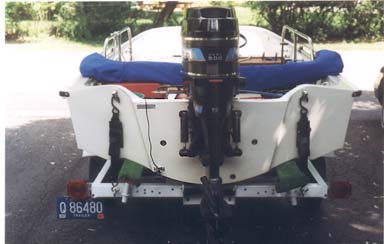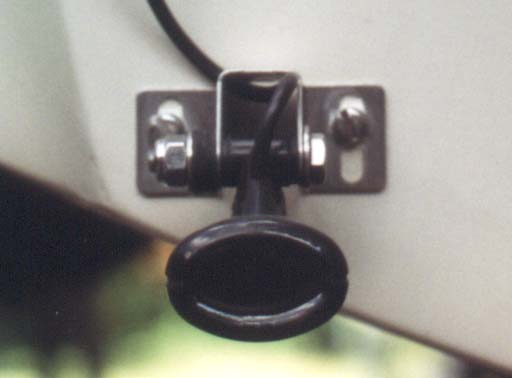
Most depthsounder or fishfinder transducers are transom mounted. There are two other options: thru-hull mounting; and in-hull mounting. Neither of these were applicable to my installation in a Boston Whaler because of the nature of the Whaler's hull contruction. The hull is filled with several inches of foam, making either of these alternative techniques impracticable.
The goal for this installation is to mount the depthsounder transducer so that it operates while the boat is travelling at speeds of up to 35 knots.
High speed operation of depthsounders or fishfinders is possible if their transducer is located properly. The transducer must be positioned so as to provide a good interface to the water at both low and high speeds. A point on the transom must be chosen that will still be immersed in the water at high speed operation and will not be obscured with aerated water from the hull. Check the hull forward from the mounting point and avoid areas directly behind strakes or notches in the hull or other areas likely to cause turbulence in the water flow.
In general, the transducer should be mounted on centerline, but clear from the lower unit of the outboard or outdrive. The transducer should not interfere with water flow into the prop, and vice versa. In single engine installations, it is also frequently suggested that the transducer be mounted on the port side because of a tendency for the propellor torque to roll the hull slightly to that side. If you have a swim ladder on the transom you may want to move the transducer to the opposite side so that it is not damaged by people using the ladder.
The manufacturer of the transducer should provide detailed mounting instructions for their particular transducer. In general, only enough of the transducer needs to be immersed to put the active face of the transducer in contact with a clear flow of water. Water coming off the hull at the transom tends to rise slightly, so the face of the transducer can be positioned to be precisely flush with the hull line as extended aft from the transom.
With the exception of flat-bottomed boats, the transom will likely have some deadrise to it. The side-to-side orientation of the mount should be made with respect to the water and not to be normal or orthoganal to the hull. Aim the transducer directly down beneath the boat; don't angle it out away from the boat just to follow the contour of the hull.
Once the mounting point on the transom has been determined, orient the transducer in the bracket to aim it directly at the bottom in the fore-and-aft plane. Many transoms are angled slightly, so this may require that the transducer not be exactly at a right angle to the transom.
At higher speeds the water pressure on the transducer will be significant, so the transducer must be securely mounted. Use stainless steel screws, and bed the screws with bedding compound like Bostik 920, Boat-Life Caulk, 3M-4200, or similar product. Be certain to make the mounting screws water-tight. They will be immersed whenever your boat is in the water. The last thing you want is water leaking into the transom to rot any wood embedded there.
I see many installations where the transducer cables are led through drain holes into the motor well. Personally, I don't like this approach. I prefer to lead the cable up and over the transom, securing it every foot or so with nylon cable clamps. (The clamps are retained with stainless steel screws and bedding compound, too.)
 |
| Transom mounted depthsounder transducer location: portside, clear of engine, still in water at speed. |
 |
| The relationsip between the bottom of the hull and the transducer body is clearly seen in this close-up view. The bracket allows for slight up and down adjustment. The transducer is aimed directly down and not aimed to align with the hull. |
With this particular installation the results have been excellent. The transducer stays in contact with clean water off the hull at all speeds. Good bottom echoes are obtained at all speeds up to the boat's maximum of 35 MPH. Also, the transducer is not throwing its own little roostertail behind the boat. The lack of such a roostertail is a sign of a good installation.
Copyright © 1999 by James W. Hebert.
This is a verified HTML 4.0 document served to you from continuousWave
URI: http://continuouswave.com
Last modified:
Author: James W. Hebert